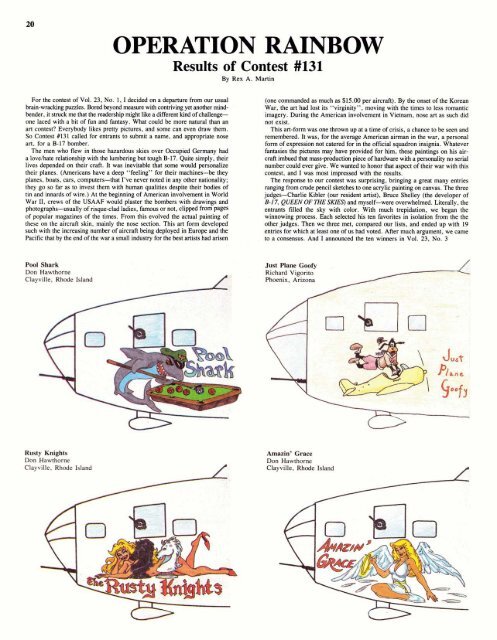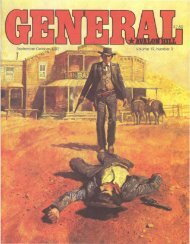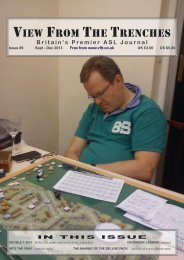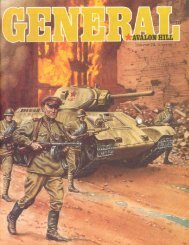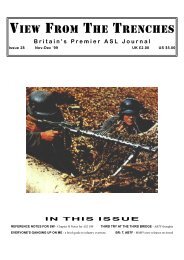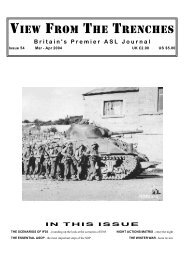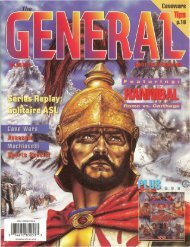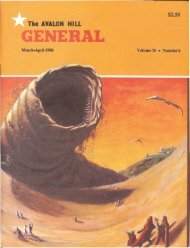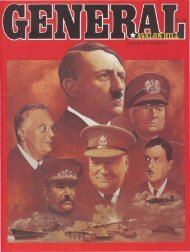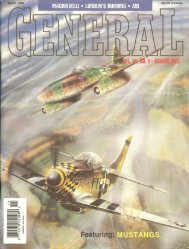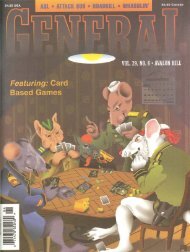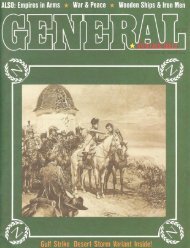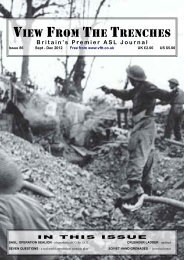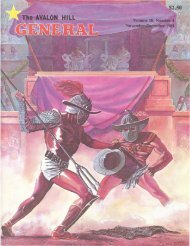18.64MB - View From The Trenches
18.64MB - View From The Trenches
18.64MB - View From The Trenches
- TAGS
- trenches
- www.vftt.co.uk
You also want an ePaper? Increase the reach of your titles
YUMPU automatically turns print PDFs into web optimized ePapers that Google loves.
OPERATION RAINBOW<br />
Results of Contest #I31<br />
By Rex A. Martin<br />
For the contest of Vol. 23, No. 1, I decided on a departure from our usual<br />
brain-wracking puzzles. Bored beyond measure with contriving yet another mind-<br />
bender, it struck me that the readership might like a different kind of challenge-<br />
one laced with a bit of fun and fantasy. What could be more natural than an<br />
art contest? Everybody likes pretty pictures, and some can even draw them.<br />
So Contest #I31 called for entrants to submit a name, and appropriate nose<br />
art, for a B-17 bomber.<br />
<strong>The</strong> men who flew in those hazardous skies over Occupied Germany had<br />
a lovethate relationship with the lumbering but tough B-17. Quite simply, their<br />
lives depended on their craft. It was inevitable that some would personalize<br />
their planes. (Americans have a deep "feeling" for their machines-be they<br />
planes, boats, cars, computers-that I've never noted in any other nationality;<br />
they go so far as to invest them with human qualities despite their bodies of<br />
tin and innards of wire.) At the beginning of American involvement in World<br />
War XI, crews of the USAAF would plaster the bombers with drawings and<br />
photographs-usually of risque-clad ladies, famous or not, clipped from pages<br />
of popular magazines of the times. <strong>From</strong> this evolved the actual painting of<br />
these on the aircraft skin, mainly the nose section. This art form developed<br />
such with the increasing number of aircraft being deployed in Europe and the<br />
Pacific that by the end of the war a small industry for the best artists had arisen<br />
Pool Shark<br />
Don Hawthorne<br />
Clayville, Rhode Island<br />
Rusty Knights<br />
Don Hawthorne<br />
Clayville, Rhode Island<br />
(one commanded as much as $15.00 per aircraft). By the onset of the Korean<br />
War, the art had lost its "virginity", moving with the times to less romantic<br />
imagery. During the American involvement in Vietnam, nose art as such did<br />
not exist.<br />
This art-form was one thrown up at a time of crisis, a chance to be seen and<br />
remembered. It was, for the average American airman in the war, a personal<br />
form of expression not catered for in the official squadron insignia. Whatever<br />
fantasies the pictures may have provided for him, these paintings on his air-<br />
craft imbued that mass-production piece of hardware with a personality no serial<br />
number could ever give. We wanted to honor that aspect of their war with this<br />
contest, and I was most impressed with the results.<br />
<strong>The</strong> response to our contest was surprising, bringing a great many entries<br />
ranging from crude pencil sketches to one acrylic painting on canvas. <strong>The</strong> three<br />
judges-Charlie Kibler (our resident artist), Bruce Shelley (the developer of<br />
B-17, QUEEN OF THE SKIES) and myself-were overwhelmed. Literally, the<br />
entrants filled the sky with color. With much trepidation, we began the<br />
winnowing process. Each selected his ten favorites in isolation from the the<br />
other judges. <strong>The</strong>n we three met, compared our lists, and ended up with 19<br />
entries for which at least one of us had voted. After much argument, we came<br />
to a consensus. And I announced the ten winners in Vol. 23, No. 3<br />
Just Plane Goofy ,<br />
Richard Vigorito<br />
Phoenix, Arizona<br />
Amazin' Grace<br />
Don Hawthorne<br />
Clayville, Rhode Island


